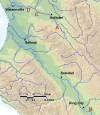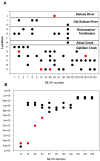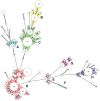Incidence and tracking of Escherichia coli O157:H7 in a major produce production region in California
- PMID: 18174909
- PMCID: PMC2174234
- DOI: 10.1371/journal.pone.0001159
Incidence and tracking of Escherichia coli O157:H7 in a major produce production region in California
Abstract
Fresh vegetables have become associated with outbreaks caused by Escherichia coli O157:H7 (EcO157). Between 1995-2006, 22 produce outbreaks were documented in the United States, with nearly half traced to lettuce or spinach grown in California. Outbreaks between 2002 and 2006 induced investigations of possible sources of pre-harvest contamination on implicated farms in the Salinas and San Juan valleys of California, and a survey of the Salinas watershed. EcO157 was isolated at least once from 15 of 22 different watershed sites over a 19 month period. The incidence of EcO157 increased significantly when heavy rain caused an increased flow rate in the rivers. Approximately 1000 EcO157 isolates obtained from cultures of>100 individual samples were typed using Multi-Locus Variable-number-tandem-repeat Analysis (MLVA) to assist in identifying potential fate and transport of EcO157 in this region. A subset of these environmental isolates were typed by Pulse Field Gel Electrophoresis (PFGE) in order to make comparisons with human clinical isolates associated with outbreak and sporadic illness. Recurrence of identical and closely related EcO157 strains from specific locations in the Salinas and San Juan valleys suggests that transport of the pathogen is usually restricted. In a preliminary study, EcO157 was detected in water at multiple locations in a low-flow creek only within 135 meters of a point source. However, possible transport up to 32 km was detected during periods of higher water flow associated with flooding. During the 2006 baby spinach outbreak investigation, transport was also detected where water was unlikely to be involved. These results indicate that contamination of the environment is a dynamic process involving multiple sources and methods of transport. Intensive studies of the sources, incidence, fate and transport of EcO157 near produce production are required to determine the mechanisms of pre-harvest contamination and potential risks for human illness.
Conflict of interest statement
Figures








References
-
- Rasmussen MA, Casey TA. Environmental and food safety aspects of Escherichia coli O157:H7 infections in cattle. Crit Rev Microbiol. 2001;27:57–73. - PubMed
-
- CDHS. Sacramento, CA: California Department of Health Services; 2004. Investigation of E. coli O157:H7 Outbreak in San Mateo Retirement Facility. http://www.dhs.ca.gov/ps/fdb/HTML/Food/EnvInvRpt.htm.
-
- CDHS. Sacramento, CA: California Department of Health Services; 2004. Investigation of E. coli O157:H7 Illnesses in San Diego and Orange Counties. http://www.dhs.ca.gov/ps/fdb/HTML/Food/EnvInvRpt.htm.
-
- CDHS. Sacramento, CA: California Department of Health Services; 2005. Addendum Report to Investigation of Pre-washed Mixed Bagged Salad following an Outbreak of Escherichia coli O157:H7 in San Diego and Orange County. http://www.dhs.ca.gov/ps/fdb/HTML/Food/EnvInvRpt.htm.
Publication types
MeSH terms
Substances
LinkOut - more resources
Full Text Sources
Other Literature Sources
Molecular Biology Databases

